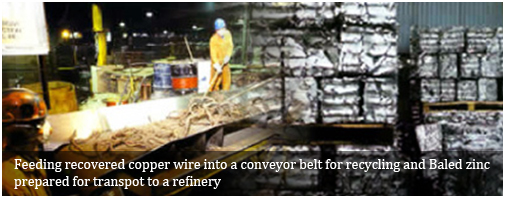
The use of scrap metal has become an integral part of the modern steelmaking industry, improving the industry's economic viability and reducing environmental impact. Compared to ore extraction, the use of secondary ferrous metals significantly reduces CO2 emissions, energy and water consumption and air pollution. At the same time, the recycling of steel makes more efficient use of the earth's natural resources.Almost 40% of the world's steel production is made from scrap. CO2 emissions are reduced by 58% through the use of ferrous scrap.
The most commonly used non-ferrous metals are aluminum, copper, lead, zinc, nickel, titanium, cobalt, chromium and precious metals. Millions of tonnes of nonferrous scrap are recovered annually and used by smelters, refiners, ingot makers, foundries, and other manufacturers. Secondary materials are essential to the industry's survival because even new metals often require the combined use of recycled materials.Almost 40% of the world's demand for copper is met using recycled material.
Sayona is equipped with all collecting and transporting machinery needed to collect the scrap. We utilize several types of balers, dump hoppers, metal shredders, cutting torches and waste compactors to perform demolition services and handle scrap in the most efficient manner. Our material packaging section uses different packaging methods depending on the material. Our balers and briquetters produce a condensed package for economical conveyance and re-melting.
Our modern production sectors operate both in job lot and production flow modes providing the efficiency and flexibility required for specialty products. Our production facility houses a plethora of machineries and equipments that qualify as technological support to accomplish our tasks.
We handle and process all grades of aluminum for recycling as well any commercial quality grade. We collect aluminum scrap, segregate aluminum and its alloys by grade, prepare them for recycling and forward them to our secondary aluminum smelters for the manufacture of aluminum ingots.
Copper scrap is collected and brought to the production sector, sorted by grade, certified, packaged into bales, briquettes or boxes and then sent to our smelters. We handle and process many grades of copper as well as copper based alloys including hard brass, red brass, yellow brass, manganese bronze and many others.
The manufacture of quality aluminum, copper and zinc alloys adheres to a defined set of alloy melting, handling, and degassing procedures.
SAYONA has an efficient structure of purchasing scrap metals from across the world and after recycling feeding this to various industries.
Non-ferrous metal recycling involves some, or all of the following steps:

Sorting: In order to be recycled appropriately, different types of non-ferrous metals need to be separated from each other, as well as from other recyclables such as paper and plastic.
Baling: Non-ferrous materials are compacted into large blocks to facilitate handling and transportation.
Shearing: Hydraulic machinery capable of exerting enormous pressure is used to cut metals into manageable sizes.
Media separation: Shredders incorporate rotating magnetic drums to separate non-ferrous from ferrous metals. Further separation is achieved using electrical currents, high-pressure air flow and liquid floating systems. Further processing may be needed.
Melting: The recovered materials are melted down in a furnace, poured into casters and shaped into ingots. These ingots are either used in the foundry industry or they can be transformed into flat sheets and other wrought products such as tubing, which are then used to manufacture new products.
Aluminium has (great recycling potential) and is often re-used for the same application for which it was originally manufactured. Its strength, flexibility and light weight, make it ideal for:
After silver, copper has the best electrical conductivity of all the elements. It is also very good thermal conductor and is readily alloyed with other metals such as lead, tin and zinc for foundry applications to produce, among other goods, products for the transmission of water such as valves.
Other common applications for recovered copper include:
Most of recycled lead is used in batteries, but the are many other applications for this metal:
Zinc is present in everyday life in the form of coins. However, it also has other important uses:
Apart from precious metals, tin is one of the most expensive non-ferrous metals. Hence, recycling from secondary materials is very important. Its applications are very varied:
The use of scrap metal has become an integral part of the modern steelmaking
industry, improving the industryâs economic viability and reducing
environmental impact.